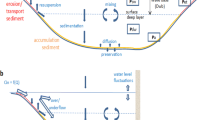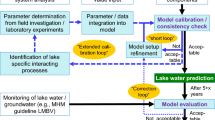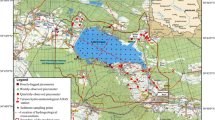Abstract
Steady-state models for the prediction of P retention coefficient (R) in lakes were evaluated using data from 93 natural lakes and 119 reservoirs situated in the temperate zone. Most of the already existing models predicted R relatively successfully in lakes while it was seriously under-estimated in reservoirs. A statistical analysis indicated the main causes of differences in R between lakes and reservoirs: (a) distinct relationships between P sedimentation coefficient, depth, and water residence time; (b) existence of significant inflow–outflow P concentration gradients in reservoirs. Two new models of different complexity were developed for estimating R in reservoirs: \(R = {1.84\tau ^{{0.5}} } \mathord{\left/ {\vphantom {{1.84\tau ^{{0.5}} } {{\left( {1 + 1.84\tau ^{{0.5}} } \right)}}}} \right. \kern-\nulldelimiterspace} {{\left( {1 + 1.84\tau ^{{0.5}} } \right)}}\), where τ is water residence time (year), was derived from the Vollenweider/Larsen and Mercier model by adding a calibrated parameter accounting for spatial P non-homogeneity in the water body, and is applicable for reservoirs but not lakes, and \(R = {1 - 1.43} \mathord{\left/ {\vphantom {{1 - 1.43} {{{\left[ {{\text{P}}_{{{\text{in}}}} } \right]}\left( {{\left[ {{\text{P}}_{{{\text{in}}}} } \right]}} \right.} \mathord{\left/ {\vphantom {{{\left[ {{\text{P}}_{{{\text{in}}}} } \right]}\left( {{\left[ {{\text{P}}_{{{\text{in}}}} } \right]}} \right.} {\left. {{\left( {1 + \tau ^{{0.5}} } \right)}} \right)}}} \right. \kern-\nulldelimiterspace} {\left. {{\left( {1 + \tau ^{{0.5}} } \right)}} \right)}}}} \right. \kern-\nulldelimiterspace} {{{\left[ {{\text{P}}_{{{\text{in}}}} } \right]}\left( {{\left[ {{\text{P}}_{{{\text{in}}}} } \right]}} \right.} \mathord{\left/ {\vphantom {{{\left[ {{\text{P}}_{{{\text{in}}}} } \right]}\left( {{\left[ {{\text{P}}_{{{\text{in}}}} } \right]}} \right.} {\left. {{\left( {1 + \tau ^{{0.5}} } \right)}} \right)}}} \right. \kern-\nulldelimiterspace} {\left. {{\left( {1 + \tau ^{{0.5}} } \right)}} \right)}}^{{0.88}} \), where [Pin] is volume-weighted P concentration in all inputs to the water body (μg l−1), was obtained by re-calibrating the OECD general equation, and is generally applicable for both lakes and reservoirs. These optimised models yield unbiased estimates over a large range of reservoir types.
Similar content being viewed by others
Avoid common mistakes on your manuscript.
Introduction
Phosphorus retention in lakes and reservoirs is usually described according to Dillon and Rigler (1974) by the retention coefficient (R) which is defined as the fraction of the external P loading retained within the water body. This retention concept is a key element of the steady steady-state, mass-balance models that have been elaborated and widely used since the 1960s for predicting nutrient concentrations and trophic state in water bodies (e.g., Chapra, 1975; Larsen & Mercier, 1976; Nürnberg, 1984; Nürnberg & LaZerte, 2004; OECD, 1982; Prairie, 1989; Vollenweider, 1969; Vollenweider, 1976).
The need to provide catchment-scale nutrient retention estimates as part of the catchment modelling efforts of the EUROHARP project http://www.euroharp.org) gave us the idea to evaluate this type of models with a data set consisting not only predominantly of lakes as in most previous studies, but also including a representative subset of reservoirs. Our preliminary studies showed that the majority of the classic models predict P retention in lakes relatively well, while P retention in reservoirs was significantly under-predicted. Hence we investigated the cause of the different behaviour of reservoirs and re-analysed relationships between the nutrient retention coefficient and the basic hydrological and morphological variables used in the models. The aim of this paper is to discuss differences between P retention in lakes and in reservoirs and to suggest how to optimise phosphorus retention models for reservoirs.
Materials and Methods
The database of phosphorus retention coefficients (available on request) consisted of 119 records for reservoirs and 93 records for lakes. The majority of the data originated from Europe and North America. Only water bodies with positive P retention were included in the database. Negative P retention (i.e., net release) was considered as a contradicting signal for the steady-state conditions assumed in this modelling approach and such data were therefore not considered.
P retention data were evaluated according to two basic approaches used in the classic steady-state P models of the 1960s and 1970s. In the first approach the P balance is solved assuming concentration-related P losses (Vollenweider, 1969), and retention coefficient R is calculated as:
where σ is P sedimentation coefficient (year−1) and τ is water residence time (year). In the second approach, the P balance is based on the areal P loading (Chapra, 1975; Vollenweider, 1975) and R is given as:
where v is P apparent settling velocity (m year−1) and q w is areal water load (m year−1).
R, σ, and v were calculated from the measured data on volume-weighted inflow ([Pin]) and outflow ([Po]) concentrations, τ, and mean depth (z) according to Chapra (1975) and Vollenweider (1975).
The evaluation of retention data from lakes and reservoirs included (a) correlation analysis among logarithmically transformed data on latitude, hydrological variables, depth, P concentrations, and R for the whole data set and for the subsets of lakes and reservoirs; (b) testing of the significance of selected relationships by regression analysis; and (c) parameter optimisation of selected functions with the Solver (MS Excel).
Results and Discussions
Characteristics of Lake and Reservoir Subsets
Our data set for P retention covered wide ranges of geographical, morphological, hydrological, and P loading conditions. Significant differences existed between the lake and reservoir subsets (Table I). Geographically, reservoirs were generally located on lower latitudes than lakes. Mean depth distribution was similar for both types of water bodies, except for the deepest category (>50 m) in which there were hardly any reservoirs. Water residence time was markedly shorter and water load higher in reservoirs than in lakes, which is in concordance with general trend (Straškraba, Tundisi, & Duncan, 1993). The P concentrations in the input were higher in reservoirs, apparently because reservoirs have often been built in densely populated and intensively used catchments. The P sedimentation coefficients σ and v were higher in reservoirs.
The results of a correlation analysis of the P retention characteristics and their potential explanatory variables can be summarised like this:
-
(a)
Geographical location was non-significant for P retention both in lakes and reservoirs.
-
(b)
[Pin] was positively correlated with the P retention characteristics (R: P < 0.001; σ: P < 0.001; v: P < 0.05), but only for reservoirs. The non-existence of this type of correlations for lakes was caused by a group of lakes in our data set with high [Pin] but very small P retention (Figure 1a). Most lakes from this group belonged to a type of lakes with high internal P loading like the lakes Norrviken, Geneva, and Hylke (Sas, 1989). The dependence of P retention on [Pin] has been recognised and used in P retention modelling in lakes and reservoirs since the beginning of 1980s (Frisk, Niemi, & Kinnunen, 1980; Kennedy, 1999; OECD, 1982).
-
(c)
Strong inter-relationship existed among z, τ, and σ, which can be seen by comparing Figures 1b-d. This fact opens the opportunity for modelling P retention in alternative ways provided that these inter-correlations are correctly described. For example, we can mention two different functional dependences in the classic models. First, the models derived from Equation (2) (Chapra, 1975; Vollenweider, 1975) include the hyperbolic relationship of σ on \( {1} \over {z} \) that can be seen also in the scatter plot in Figure 1c. Second, the model of Larsen and Mercier (1976) and Vollenweider (1976) is derived from Equation (1) by substitution of σ by its dependence on τ, i.e., \( \sigma = \frac{1} {{{\sqrt \tau }}} \), to give the formulation of retention coefficient:
$$ R = {{{{\sqrt \tau }}} \over{{1 + {\sqrt \tau }}}}. $$(3)Interestingly, our lake subset of P retention data gave almost exactly the same parameters for the relationship between τ and σ (i.e., σ = 0.83τ −0.49; Figure 1b) as in the original paper of Mercier and Larsen (1976) (cf. relationship (7): σ = 0.761τ −0.472).
-
(d)
The relationships between z, τ, and σ (P < 0.05) differed significantly in parameters between the lake and reservoir subsets (Figure 1b-d), and we consider these differences as the key point for explaining the difference in P retention between lakes and reservoirs. The differences in P retention seem to derive from the different relationships between τ and z in lakes and reservoirs (Figure 1d). Water residence time is on average 3.3–4 times longer in lakes than in reservoirs with similar depth (as calculated for the range of depth between 1 and 100 m with the regression equations in Figure 1d). This difference can have limnological consequences with implications also for P-retention. Higher flow at a similar depth in reservoirs implies that reservoirs have less stable as well as shorter periods of thermal stratification, which can be further augmented by the fact that outlets of reservoirs are often located near the bottom. Higher inflow and less stable stratification means that more dissolved oxygen is available at the water-sediment interface in the hypolimnion of reservoirs than in lakes, and thus sediments in reservoirs are on average more oxygenated and consequently have larger capacity for P-binding and are less prone to P release than sediments in lakes.
Selected relationships between P sedimentation coefficient (σ), input P concentration [Pin], water residence time τ, and mean depth (z) for lake (open triangles and dashed line) and reservoir (full circles and full line) subsets. Regression equations contain standard error of parameter estimates in parenthesis.
Evaluation of Models
A comparison of R measured and predicted by representatives of various types of models from the literature is presented in Table II. A relatively high error of prediction can be seen with all models, which conforms to the scatter within the data set. The classic models I to V slightly over-predicted P-retention in lakes (on average by 8%–18%) except for the model of Prairie (1989) that gave a lower mean value (−9%). P-retention in reservoirs was significantly underestimated (by 9%–36%), except for the model OECD (1982) that gave higher results (+11%). The models based on the dependence of σ as a function of τ −0.5 (i.e., models I and III) showed lower absolute mean error (AME) for both lakes and reservoirs if compared with the models that use the negative hyperbolic dependence of σ on depth (i.e., \( \sigma = \frac{v} {z} \); models II, IV, and V). A relatively small difference in results for lakes and reservoirs and a low prediction error had model III (i.e., the general equation of OECD, 1982). This model includes also the dependence of P-retention on [Pin], which apparently compensated the differences between lakes and reservoirs in the relationships among σ, τ, and z. This small comparison of diverse types of models indicated that (a) P-retention in reservoirs has to be predicted by differently parametrised models in comparison with models for lakes if these models are based only on hydrological and morphological variables (i.e., τ and z) and (b) a general model for both lakes and reservoirs must include other variables like inflow P concentration.
These results described above encouraged us to proceed in selecting and calibrating the best suitable P-retention models for our dataset in two ways.
Firstly, we developed a simple model for reservoirs only. For this purpose we adjusted the Vollenweider/Larsen–Mercier model, i.e., Equation (3), to fit the dependence of σ on τ according to Figure 1b in the form of
The optimised value of coefficient a for the reservoir subset was 1.84, and lied within the confidence interval of the regression equation in Figure 1b. Compared with the classic models, this model gave the lowest prediction error (Table II). However, it is clear that it cannot be used in lakes because of highly over-estimated retention results.
Secondly, in order to set up a general model for both lakes and reservoirs in our entire dataset we optimised parameters of the OECD model (OECD, 1982):
The optimised values for parameters a and b were 1.43 and 0.88, respectively. This model only slightly over-predicted or under-predicted the average values of R in lakes or reservoirs, respectively (model VII in Table II). The prediction error was for reservoirs the best of all the tested models and for lakes differed only by 0.01 from that obtained with the Vollenweider/Larsen–Mercier model.
Conclusions
We can conclude with a general statement as in similar studies before that simple empirical P retention models can be useful management and research tools if the limitations of the models are recognised. The P retention models for reservoirs were developed in this study from data covering a broad geographic area and a wide range of limnological conditions. The developed models should be applied with caution, however, to water bodies not being in steady-state conditions. The models probably will work equally well throughout the whole temperate region, but they should be tested before being used in other areas of the world.
References
Chapra, S. C. (1975). Comment on ‘An empirical method of estimating the retention of phosphorus in lakes’, by W. B. Kirchner and P. J. Dillon. Water Resources Research, 2, 1033–1034.
Dillon, P. J., & Rigler, F. H. (1974). A test of a simple nutrient budget model predicting the phosphorus concentration in lake water. Journal of the Fisheries Research Board of Canada, 31, 1771–1778.
Frisk, T., Niemi, J. S., & Kinnunen, K. A. I. (1980). Comparison of statistical phosphorus-retention models. Ecological Modelling, 12, 11–27.
Kennedy, R. H. (1999). Basin-wide considerations for water quality management: Importance of phosphorus retention by reservoirs. International Review of Hydrobiology, 84, 557–566.
Larsen, D. P., & Mercier, H. T. (1976). Phosphorus retention capacity in lakes. Journal of the Fisheries Research Board of Canada, 33, 1742–1750.
Nürnberg, G. K. (1984). The prediction of internal phosphorus load in lakes with anoxic hypolimia. Limnology and Oceanography, 29, 111–124.
Nürnberg, G. K., & LaZerte, B. D. (2004). Modeling the effect of development on internal phosphorus load in nutrient-poor lakes. Water Resources Research, 40, art. no. w01105 (Jan 27).
OECD (1982). Eutrophication of Waters: Monitoring, Assessment and Control. Paris: OECD.
Prairie, Y. T. (1989). Statistical models for the estimation of net phosphorus sedimentation in lakes. Aquatic Sciences, 51, 192–210.
Sas, H. (1989). Lake Restoration by Reduction of Nutrient Loading: Expectations, Experiences, Extrapolations. Richarz: Academia Verlag.
Straškraba, M., Tundisi, J. G., & Duncan, A. (1993). State-of-the-art of reservoir limnology and water quality management. In M. Straškraba, J. G. Tundisi & A. Duncan (Eds.), Comparative Reservoir Limnology and Water Quality Management (pp. 113–188). Dordrecht: Kluwer.
Vollenweider, R. A. (1969). Möglichkeiten und Grenzen elementarer Modelle der Stoffbilanz von Seen. Archiv fuÉr Hydrologie, 66, 1–36.
Vollenweider, R. A. (1975). Input–output models with special reference to the phosphorus loading concept in limnology. Schweizerische Zeitschrift Hydrobiologie, 37, 53–84.
Vollenweider, R. A. (1976). Advances in defining critical loading levels for phosphorus in lake eutrophication. Memorie dell’Istituto Italiano di Idrobiologia, 33, 53–83.
Acknowledgements
This study was supported by the EU project EUROHARP, no. EVK1-CT-2001-00096, the Grant Agency of the AS CR, project no. A3017301, and partly by the projects AS CR no. 1QS600170504 and MSM 6007665801. We are grateful Dr Gertrud K. Nürnberg for the help with collecting the P retention data from lakes.
Author information
Authors and Affiliations
Corresponding author
Rights and permissions
About this article
Cite this article
Hejzlar, J., Šámalová, K., Boers, P. et al. Modelling Phosphorus Retention in Lakes and Reservoirs. Water Air Soil Pollut: Focus 6, 487–494 (2006). https://doi.org/10.1007/s11267-006-9032-7
Published:
Issue Date:
DOI: https://doi.org/10.1007/s11267-006-9032-7





